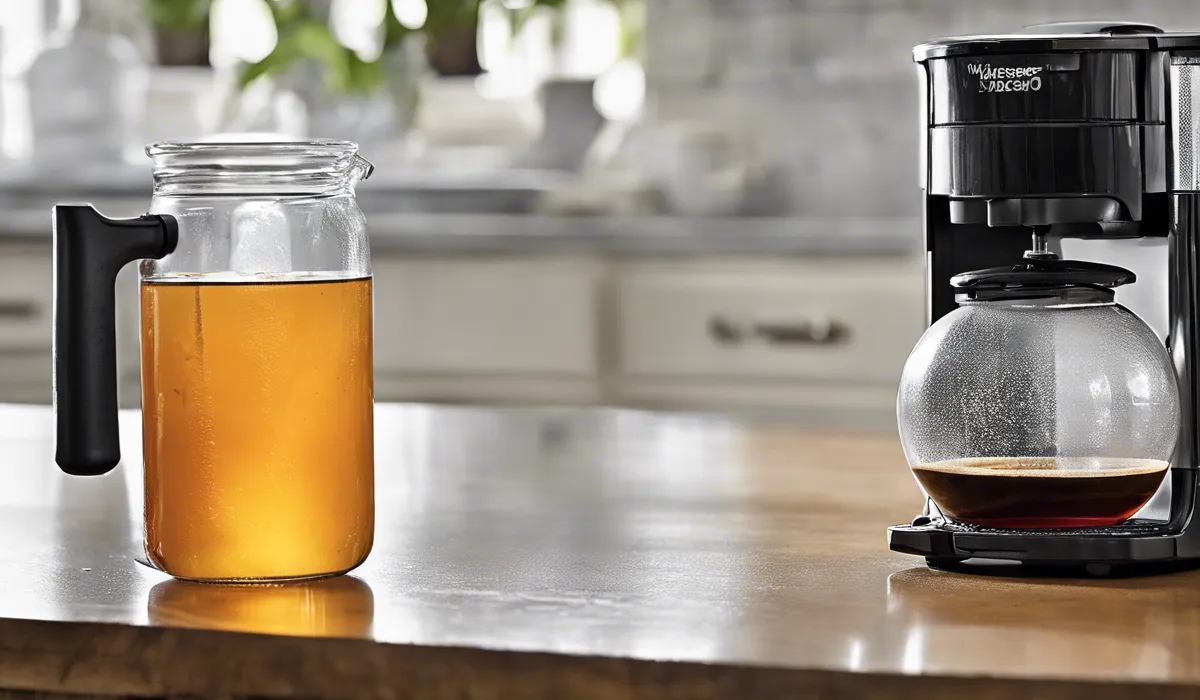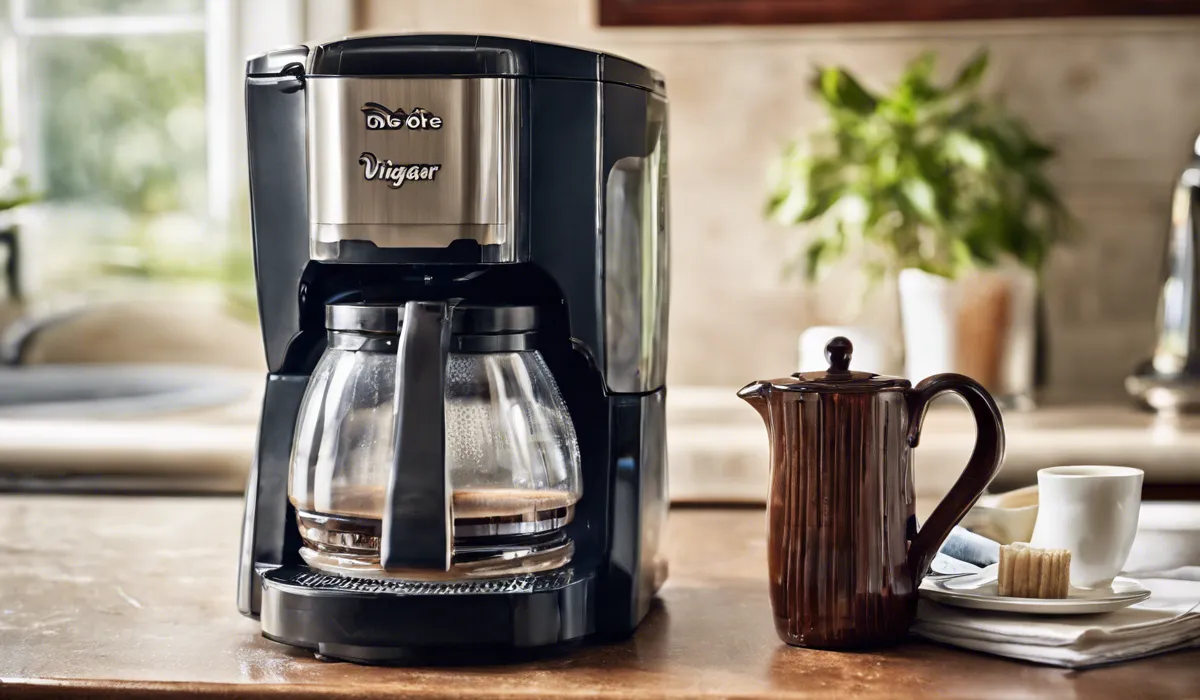Yes, vinegar can kill mold in a coffee maker by using its acetic acid content to break down mold growth. To clean, fill the water reservoir with equal parts white vinegar and water, run a brewing cycle, then run 2-3 cycles with clean water to rinse.
Science Behind Vinegar as a Mold-Killing Agent

Properties of Vinegar Effective Against Mold
Vinegar is more than just a kitchen staple; it’s a powerful cleaning agent. Its secret weapon against mold is acetic acid, which can penetrate and kill mold at its roots.
The acetic acid in vinegar disrupts mold’s essential functions, preventing it from growing and spreading. This makes vinegar a natural and non-toxic alternative to harsh chemical cleaners.
Types of Vinegar and Acidity Levels
Not all vinegars are created equal when it comes to mold removal. White vinegar, with an acidity level of about 5%, is most commonly recommended for cleaning because it strikes the right balance between potency and safety.
Apple cider vinegar can also be used, though it might be slightly less effective due to its lower acidity.
How Acidity Interrupts Mold Growth
Acidity is the kryptonite of mold. Mold thrives in neutral to slightly acidic environments, so the introduction of a highly acidic substance like vinegar can halt its growth.
The acid damages the structure and enzymes of mold spores, rendering them inert and preventing them from reproducing.
Comparison with Commercial Mold Removers
While vinegar is a great natural option, it’s worth noting that commercial mold removers often contain stronger chemicals that can kill mold more quickly.
However, these chemicals can be harmful to breathe and touch, making vinegar a safer choice for households, especially those with children, pets, or individuals with sensitivities to chemicals.
Using Vinegar to Clean a Coffee Maker

Step-by-Step Guide to Cleaning with Vinegar
Cleaning your coffee maker with vinegar is simple and effective. Start by mixing equal parts white vinegar and water in the reservoir.
Begin a brewing cycle and let half of the mixture run through before pausing for an hour to let the vinegar solution soak and work its magic.
Afterward, complete the cycle and follow up with two to three cycles of clean water to rinse the machine thoroughly.
Frequency of Cleaning to Prevent Mold
To keep your coffee maker free of mold, aim to clean it with vinegar every month or more frequently if you use it heavily.
This routine not only keeps mold at bay but also removes mineral deposits and other build-ups, ensuring your coffee tastes fresh every time.
Safety Precautions When Using Vinegar in Appliances
When using vinegar in your coffee maker, ensure the appliance is off and cool. Also, be mindful of the mixture’s strength.
If your coffee maker has rubber or plastic components, too strong a vinegar solution might cause deterioration over time. Always follow with several water cycles to eliminate any potential vinegar taste in your next brew.
Tips for Ensuring All Parts of the Coffee Maker Are Mold-Free
Don’t forget the removable parts! Wash the pot, filter basket, and any other detachable components with vinegar and water by hand.
For hard-to-reach areas, use a brush or cloth dipped in vinegar to scrub away any mold or residue. Allow all parts to air dry completely before reassembling to prevent mold from returning.
Limitations and Considerations

Types of Mold That May Not Be Killed by Vinegar
While vinegar is effective against many types of mold, some species, particularly those that are more resistant to acidic environments, may not be as easily eradicated.
In these cases, you may need to resort to stronger cleaning agents or professional mold removal services.
Potential Impact of Vinegar on Coffee Maker Materials and Longevity
Regular use of vinegar in your coffee maker is generally safe, but excessive exposure to acidity can wear down certain materials over time.
Pay attention to any changes in the components of your coffee maker and dilute the vinegar solution if necessary.
Alternatives to Vinegar for Mold Prevention and Cleaning
If you’re seeking alternatives to vinegar, consider using hydrogen peroxide or baking soda solutions.
These substances also possess mold-killing properties without the potent smell of vinegar. However, always check your coffee maker’s manual before using alternative cleaning agents to avoid damage.
Importance of Regular Maintenance Beyond Mold Removal
Maintaining a clean coffee maker isn’t just about mold prevention. Regular cleaning extends the life of your appliance and ensures the best flavor for your coffee.
Make a habit of wiping down the exterior, emptying the grounds after each use, and deep-cleaning with vinegar or other safe cleaners as part of your kitchen routine.
FAQs About Cleaning Coffee Makers with Vinegar
Can vinegar effectively kill mold in a coffee maker?
Yes, vinegar can effectively kill mold in a coffee maker due to its acetic acid content.
What type of vinegar should be used to clean a coffee maker?
White vinegar is typically used for cleaning a coffee maker due to its disinfectant properties.
How do I use vinegar to clean my coffee maker?
Fill the water reservoir with equal parts white vinegar and water, run a brewing cycle, then follow with 2-3 cycles of clean water to rinse.
How many rinse cycles should I run after cleaning with vinegar?
After cleaning with vinegar, run 2-3 rinse cycles with clean water to ensure all vinegar is removed.
Is cleaning a coffee maker with vinegar safe for all types of coffee makers?
Cleaning with vinegar is safe for most coffee makers, but always check the manufacturer’s instructions first.
Final Thoughts
Vinegar is an effective mold killer for coffee makers, leveraging acetic acid to combat mold growth.
A cleaning solution of half white vinegar and half water, cycled through the brewing process, can address mold issues.
Afterward, several cycles of clear water are necessary to thoroughly rinse the machine, ensuring no vinegar taste lingers in future cups of coffee.
